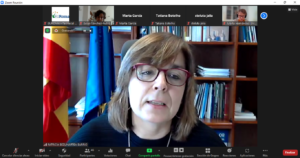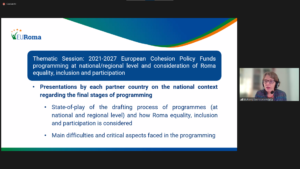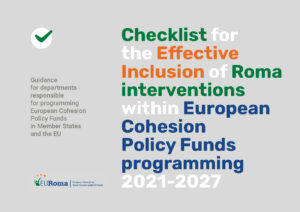The latest EURoma Management Committee meeting, held on 13-14 December, gathered representatives of 13 EURoma partner countries and of the European Commission to review relevant EU financial and policy developments and to exchange on how Roma equality, inclusion and participation is being considered in the 2021-2027 European Cohesion Policy Funds.
On 13 and 14 December the EURoma Network organised its latest Management Committee meeting (the third one online given the current circumstances). The meeting gathered representatives of Network partner organisations (public bodies responsible for European Cohesion Policy Funds -mainly ESF/ESF+ and ERDF- and those in charge of Roma policies, notably National Roma Contact Points) from 13 EU Member States and representatives of the Network Technical Secretariat (Fundación Secretariado Gitano). As usual, it also counted on the involvement of European Commission’s Directorate-Generals (DGs) with competences in Roma inclusion, the ESF/ESF+ and the ERDF, in particular DG Justice and Consumers (DG JUST), DG Regional and Urban Policy (DG REGIO) and DG Employment, Social Affairs and Inclusion (DG EMPL).
Welcome and opening remarks
 Patricia Bezunartea,Director General of Family Diversity and Social Services at the Spanish Ministry of Social Rights and 2030 Agenda, was in charge of opening the meeting on behalf of Spanish Network partners (as Network leading country). She shared with participants some initial thoughts on the role that EURoma can play to promote an increased alignment between the policy and the financial frameworks now that we are in the final stages of the adoption of the National Strategic Frameworks for Roma equality, inclusion and participation and the elaboration of the 2021-2027 ESF+ and ERDF programmes.
Patricia Bezunartea,Director General of Family Diversity and Social Services at the Spanish Ministry of Social Rights and 2030 Agenda, was in charge of opening the meeting on behalf of Spanish Network partners (as Network leading country). She shared with participants some initial thoughts on the role that EURoma can play to promote an increased alignment between the policy and the financial frameworks now that we are in the final stages of the adoption of the National Strategic Frameworks for Roma equality, inclusion and participation and the elaboration of the 2021-2027 ESF+ and ERDF programmes.
In line with EURoma’s objective to promote an increased and more effective use of European Structural and Investment Funds (ESI Funds)/European Cohesion Policy Funds for the promotion of social inclusion, equal opportunities and the fight against discrimination of the Roma population, the meeting pursued three main objectives:
1. Review of relevant EU developments regarding European Cohesion Policy Funds and Roma equality, inclusion and participation
The meeting started with the review of the latest EU developments of relevance for promoting Roma equality, inclusion and participation. Particular attention was paid to the opportunities offered and, building upon the core mission of the Network, to the connection between the policy and financial frameworks.
Firstly, participants discussed about the developments related to the policy framework and other initiatives, including the state-of-play of submission the Roma National Strategic Frameworks for equality, inclusion and participation, the implementation of the European Anti-Racism Action Plan 2020-2025 and the Roma Civil Monitor Initiative (Preparatory Action-Strengthening capacity and involvement of Roma and pro-Roma civil society un policy monitoring and review).
Secondly, they analysed the EU financial framework and other EU financial instruments relevant for Roma equality, inclusion and participation. In addition to reviewing the state-of-play of the elaboration of the European Cohesion Policy Funds programmes for the 2021-2027 period (in particular ESF+ and ERDF), participants had the opportunity to get updated on other financial instruments of relevance such as the Recovery and Resilience Facility, the implementation of the European Child Guarantee and the Reinforced Youth Guarantee.
2. Consideration of Roma equality, inclusion and participation in 2021-2027 European Cohesion Policy Funds
 A great deal of the meeting focused on the exchange and discussion on how Roma equality, inclusion and participation are being considered in the 2021-2027 ESF+ and ERDF programmes that Member States are currently elaborating.
A great deal of the meeting focused on the exchange and discussion on how Roma equality, inclusion and participation are being considered in the 2021-2027 ESF+ and ERDF programmes that Member States are currently elaborating.
Partners firstly shared information on the state-of-play of the drafting process (considering the national and the regional levels) and the options considered, for example in terms of funds, geographical scope, specific objectives, approaches, priority areas and types of measures, among others. Particular attention was paid to the selection of ESF+ Specific Objective (j) (Promoting the socio-economic integration of marginalised communities, such as Roma people) and ERDF Specific Objective 4(iii) (Increasing the socioeconomic integration of marginalised communities, migrants and disadvantaged groups, through integrated measures including housing and social services).
This exchange also helped identify critical aspects and main difficulties faced and possible solutions to address them.
 References to many of these critical aspects can be found in EURoma’s Checklist for the effective inclusion of Roma interventions within EU Cohesion Funds programming 2021-2027. This document aims to offer guidance to EU, national and regional departments responsible for programming EU Cohesion Funds (especially ESF+ and ERDF) on how to set the adequate basis in the programming documents, mainly the Partnership Agreement and the EU Cohesion Funds programmes, to ensure that measures implemented in the future have a real impact and contribute to reducing Roma exclusion and discrimination effectively.
References to many of these critical aspects can be found in EURoma’s Checklist for the effective inclusion of Roma interventions within EU Cohesion Funds programming 2021-2027. This document aims to offer guidance to EU, national and regional departments responsible for programming EU Cohesion Funds (especially ESF+ and ERDF) on how to set the adequate basis in the programming documents, mainly the Partnership Agreement and the EU Cohesion Funds programmes, to ensure that measures implemented in the future have a real impact and contribute to reducing Roma exclusion and discrimination effectively.
3. EURoma Network activities and products
Finally, partners discussed and agreed on the next EURoma activities for 2022 in line with its three strategic lines of action:
- Mutual learning and transfer of knowledge and experience
- Generation of knowledge based on experience
- Involvement in relevant consultative and decision-making spaces as well as other initiatives of European/international organisations

